The AMD Radeon R9 270X & R9 270 Review: Feat. Asus & HIS
by Ryan Smith on November 13, 2013 12:01 AM ESTCompute
Jumping into compute, we’re once again treading into familar territory. Pitcairn is Pitcairn is Pitcairn, and for the 270 series this will result in the same general performance increases we've seen elsewhere. 270 will of course be the bigger winner, owing to its upgrade to a fully enabled Pitcairn part. Also, on a quick housekeeping note we'll only be looking at the HIS 270 here. Our primary interest is on a broad architectural basis, rather than the minor impact from factory overclocks.
As always we'll start with our DirectCompute game example, Civilization V, which uses DirectCompute to decompress textures on the fly. Civ V includes a sub-benchmark that exclusively tests the speed of their texture decompression algorithm by repeatedly decompressing the textures required for one of the game’s leader scenes. While DirectCompute is used in many games, this is one of the only games with a benchmark that can isolate the use of DirectCompute and its resulting performance.
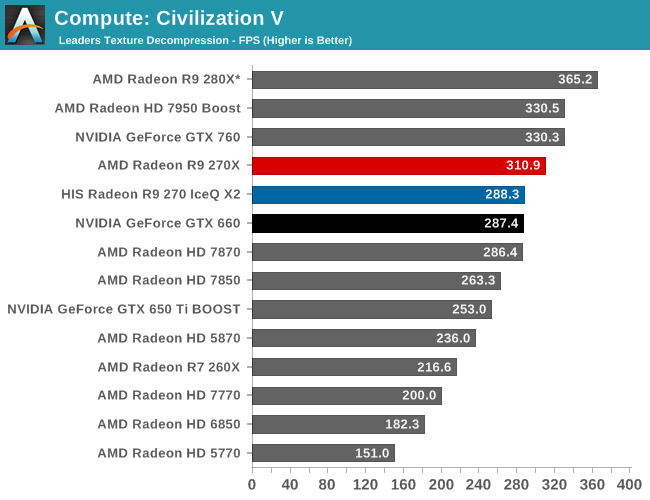
Both 270 cards do well for themselves here. The 270X holds the overall edge of course, though it’s interesting to note that the 270 and GTX 660 are virtually tied here.
Our next benchmark is LuxMark2.0, the official benchmark of SmallLuxGPU 2.0. SmallLuxGPU is an OpenCL accelerated ray tracer that is part of the larger LuxRender suite. Ray tracing has become a stronghold for GPUs in recent years as ray tracing maps well to GPU pipelines, allowing artists to render scenes much more quickly than with CPUs alone.
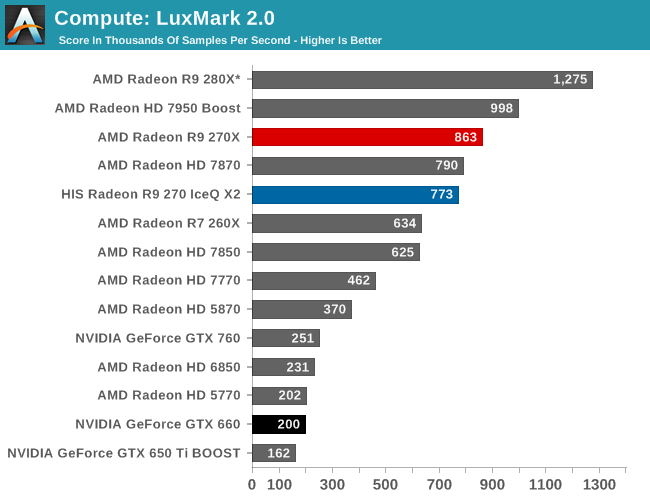
AMD consistently rules the roost on LuxMark, so there aren’t any surprises here. This chart is essentially just the AMD GCN cards sorted by performance, followed by their older VLIW cards and the GeForce cards.
Our 3rd compute benchmark is Sony Vegas Pro 12, an OpenGL and OpenCL video editing and authoring package. Vegas can use GPUs in a few different ways, the primary uses being to accelerate the video effects and compositing process itself, and in the video encoding step. With video encoding being increasingly offloaded to dedicated DSPs these days we’re focusing on the editing and compositing process, rendering to a low CPU overhead format (XDCAM EX). This specific test comes from Sony, and measures how long it takes to render a video.
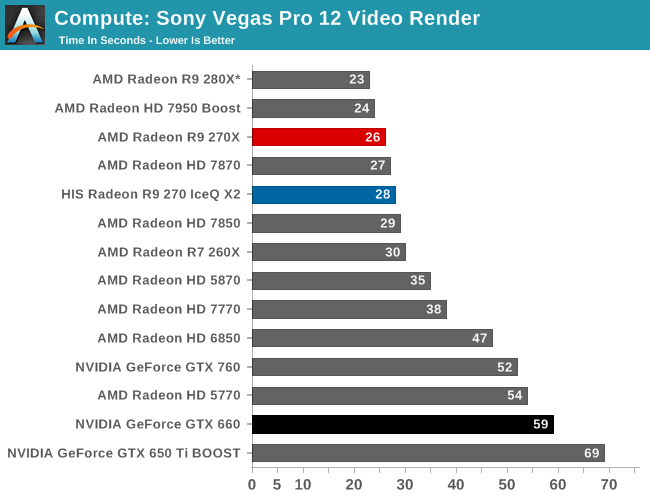
Like LuxMark, Sony Vegas is a benchmark dominated by AMD. The lead here is so great that the 270 could run this benchmark twice over before the GTX 660 completed it once.
Our 4th benchmark set comes from CLBenchmark 1.1. CLBenchmark contains a number of subtests; we’re focusing on the most practical of them, the computer vision test and the fluid simulation test. The former being a useful proxy for computer imaging tasks where systems are required to parse images and identify features (e.g. humans), while fluid simulations are common in professional graphics work and games alike.
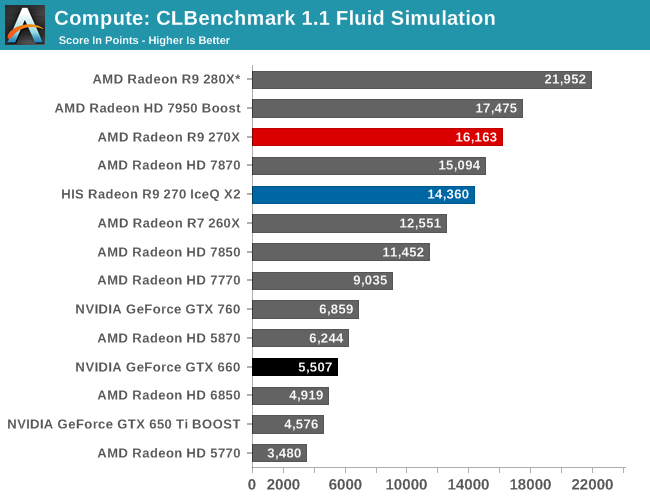
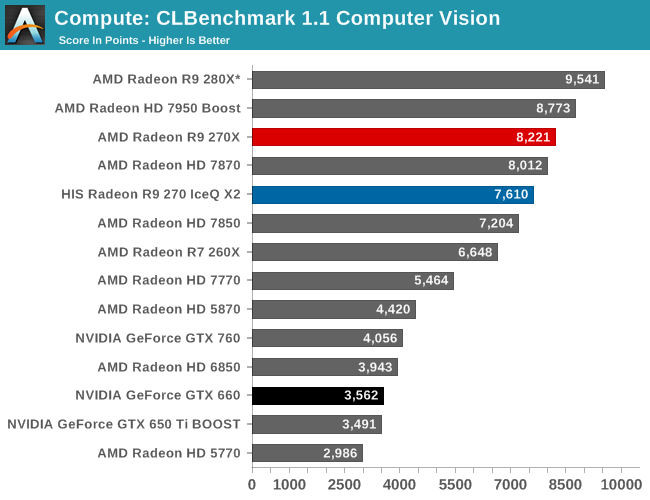
Both CLBenchmark’s fluid simulation benchmark and the computer vision benchmark go to AMD here. The GTX 660 and GTX 760 are not competitive here.
Moving on, our 5th compute benchmark is FAHBench, the official Folding @ Home benchmark. Folding @ Home is the popular Stanford-backed research and distributed computing initiative that has work distributed to millions of volunteer computers over the internet, each of which is responsible for a tiny slice of a protein folding simulation. FAHBench can test both single precision and double precision floating point performance, with single precision being the most useful metric for most consumer cards due to their low double precision performance. Each precision has two modes, explicit and implicit, the difference being whether water atoms are included in the simulation, which adds quite a bit of work and overhead. This is another OpenCL test, as Folding @ Home has moved exclusively to OpenCL this year with FAHCore 17.
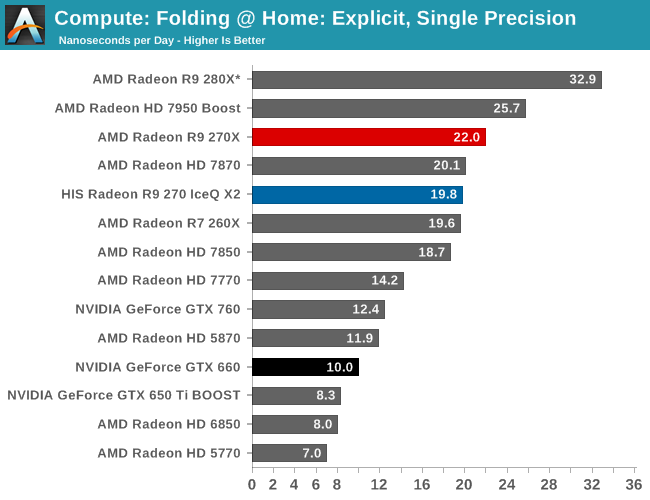
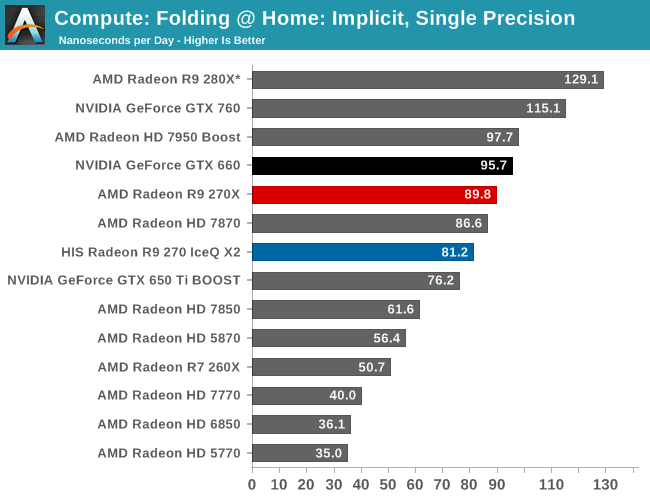
When it comes to Folding@Home, the winner is highly dependent on the specific test. For the explicit simulation the GTX 660 is a significant laggard, leaving the 270 series to take the top spots for sub-$200 cards. In the implicit test however none of the 270 cards can hold their ground against the GTX 660, not even the 270X. Folding@Home uses a mix of these data types so there won’t be any one clear winner, but the 270 series loses by a smaller margin in implicit than the GTX 660 does in explicit.
Wrapping things up, our final compute benchmark is an in-house project developed by our very own Dr. Ian Cutress. SystemCompute is our first C++ AMP benchmark, utilizing Microsoft’s simple C++ extensions to allow the easy use of GPU computing in C++ programs. SystemCompute in turn is a collection of benchmarks for several different fundamental compute algorithms, as described in this previous article, with the final score represented in points. DirectCompute is the compute backend for C++ AMP on Windows, so this forms our other DirectCompute test.

SystemCompute is another compute benchmark that goes to AMD. The 270 and 270X handily beat the GTX 760, never mind the GTX 660.










59 Comments
View All Comments
iTzSnypah - Wednesday, November 13, 2013 - link
I'm not sure I like the R9 270. It should have been a cut card ~18CU's. I mean you can edit the BIOS to let up to +50% power limit so the only differentiation of the 270 and 270X (power) can be side stepped rather easily.The only hope is the 270X is binned much much higher than the 270 (to the point where the 270's are dogs), else there really isn't that much reason to buy one.
Also I'm surprised that the ASUS R9 270 wasn't a single 8pin connector.
blanarahul - Wednesday, November 13, 2013 - link
A single 8-pin connector would essentially make it a 270X.Gnarr - Wednesday, November 13, 2013 - link
Are you really complaining that the card is not handicapped enough and that you can get a very powerful card for a low price? And you say that you don't like that you can get this card this cheap?P39Airacobra - Saturday, May 31, 2014 - link
WTH? Really? That is the dumbest thing I ever heard! That is like getting a million dollars and then saying you should have got less. What is wrong with you?I am glad the 270 is just the same as the 270X, I only paid $179 for it, And all I have to do is go into CCC and set my clock from 925mhz to 1050, And bam I got 270X , And with better power efficiency. However I leave it at 925mhz because it has more than enough power to max most games at stock. You can't get a better deal than this right now. Now if AMD can just get their drivers right and keep the artifact problem gone. So far 14.4 stable has no artifacts, But the new 14.6 beta has artifacts in games that require physx, (like Mafia 2) So I just keep 14.4 installed. It's sad that it has been over 2 years and AMD is still having artifact problems in their drivers. This has effected allot of 280/280X users. Some figure out that it is the drivers, And others just returned their cards, It's amazing how nobody wants to admit what the real problem is, It is like they want to worship and praise AMD instead of solving the artifact issue.
The Von Matrices - Wednesday, November 13, 2013 - link
The 270X seems like a pointless card to anyone willing to adjust clock speeds since it is the same GPU as its cheaper sibling, much like the 7970 GHz edition was to the 7970. I remember most 7970s (including mine) easily clocked to 7970 GHz edition speeds with little or no voltage increase. Is the 270 the same in regards to reaching the clock speed of the 270X?kyuu - Wednesday, November 13, 2013 - link
I'm guessing the difference will be binning. So while you might end up with a 270 that can clock up to (or beyond) a 270X, there's a chance you may not if you were unlucky and ended up with lower quality silicon.blanarahul - Wednesday, November 13, 2013 - link
The difference will be TDP. I think the 270 is already operating near it's power limit. But the 270X has a lot of headroom.yacoub35 - Wednesday, November 13, 2013 - link
The right choice would be to get a 7950 Boost for under $200 and skip the 270-series generation which is rebranded lower-level hardware.doggghouse - Wednesday, November 13, 2013 - link
Yeah, the 7950 Boost is a great bargain for now... until the supplies dry up. I managed to grab one for my nephew's new PC for $160 after rebate! It even came with the Never Settle Gold... going to be a great addition to his first PC :)garadante - Wednesday, November 13, 2013 - link
I'm not sure if I'm missing the section that points it out, but what does the asterisk behind the 280X in the graphs represent? Does it represent some sort of caveat or warning that we should be aware of?